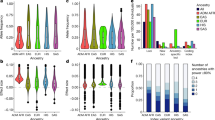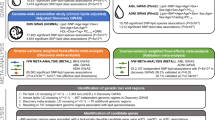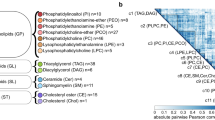Abstract
To identify genetic variants influencing plasma lipid concentrations, we first used genotype imputation and meta-analysis to combine three genome-wide scans totaling 8,816 individuals and comprising 6,068 individuals specific to our study (1,874 individuals from the FUSION study of type 2 diabetes and 4,184 individuals from the SardiNIA study of aging-associated variables) and 2,758 individuals from the Diabetes Genetics Initiative, reported in a companion study in this issue. We subsequently examined promising signals in 11,569 additional individuals. Overall, we identify strongly associated variants in eleven loci previously implicated in lipid metabolism (ABCA1, the APOA5-APOA4-APOC3-APOA1 and APOE-APOC clusters, APOB, CETP, GCKR, LDLR, LPL, LIPC, LIPG and PCSK9) and also in several newly identified loci (near MVK-MMAB and GALNT2, with variants primarily associated with high-density lipoprotein (HDL) cholesterol; near SORT1, with variants primarily associated with low-density lipoprotein (LDL) cholesterol; near TRIB1, MLXIPL and ANGPTL3, with variants primarily associated with triglycerides; and a locus encompassing several genes near NCAN, with variants strongly associated with both triglycerides and LDL cholesterol). Notably, the 11 independent variants associated with increased LDL cholesterol concentrations in our study also showed increased frequency in a sample of coronary artery disease cases versus controls.
This is a preview of subscription content, access via your institution
Access options
Subscribe to this journal
Receive 12 print issues and online access
$209.00 per year
only $17.42 per issue
Buy this article
- Purchase on Springer Link
- Instant access to full article PDF
Prices may be subject to local taxes which are calculated during checkout

Similar content being viewed by others
References
Mackay, J. & Mensah, G.A. The Atlas of Heart Disease and Stroke (World Health Organization, Geneva, 2004).
Law, M.R., Wald, N.J. & Rudnicka, A.R. Quantifying effect of statins on low density lipoprotein cholesterol, ischaemic heart disease, and stroke: systematic review and meta-analysis. Br. Med. J. 326, 1423 (2003).
Kuulasmaa, K. et al. Estimation of contribution of changes in classic risk factors to trends in coronary-event rates across the WHO MONICA Project populations. Lancet 355, 675–687 (2000).
Clarke, R. et al. Cholesterol fractions and apolipoproteins as risk factors for heart disease mortality in older men. Arch. Intern. Med. 167, 1373–1378 (2007).
Grundy, S.M. et al. Implications of recent clinical trials for the National Cholesterol Education Program Adult Treatment Panel III guidelines. Circulation 110, 227–239 (2004).
Gotto, A.M. Jr. & Brinton, E.A. Assessing low levels of high-density lipoprotein cholesterol as a risk factor in coronary heart disease: a working group report and update. J. Am. Coll. Cardiol. 43, 717–724 (2004).
Prospective Studies Collaboration. Blood cholesterol and vascular mortality by age, sex and blood pressure: a meta-analysis of individual data from 61 prospective studies with 55,000 vascular deaths. Lancet 370, 1829–1839 (2007).
Bansal, S. et al. Fasting compared with nonfasting triglycerides and risk of cardiovascular events in women. J. Am. Med. Assoc. 298, 309–316 (2007).
Nordestgaard, B.G., Benn, M., Schnohr, P. & Tybjaerg-Hansen, A. Nonfasting triglycerides and risk of myocardial infarction, ischemic heart disease, and death in men and women. J. Am. Med. Assoc. 298, 299–308 (2007).
Pilia, G. et al. Heritability of cardiovascular and personality traits in 6,148 Sardinians. PLoS Genet. 2, e132 (2006).
Pollin, T.I. et al. A genome-wide scan of serum lipid levels in the Old Order Amish. Atherosclerosis 173, 89–96 (2004).
Breslow, J.L. Genetics of lipoprotein abnormalities associated with coronary artery disease susceptibility. Annu. Rev. Genet. 34, 233–254 (2000).
Scott, L.J. et al. A genome-wide association study of type 2 diabetes in Finns detects multiple susceptibility variants. Science 316, 1341–1345 (2007).
Scuteri, A. et al. Genome-wide association scan shows genetic variants in the FTO gene are associated with obesity related traits. PLoS Genet. 3, e115 (2007).
Saxena, R. et al. Genome-wide association analysis identifies loci for type 2 diabetes and triglyceride levels. Science 316, 1331–1336 (2007).
Kathiresan, S. et al. Six new loci associated with blood low-density lipoprotein cholesterol, high-density lipoprotein cholesterol or triglycerides in humans. Nat. Genet. advance online publication 13 January 2008; 10.1038/ng.75.
Chen, W.M. & Abecasis, G.R. Family-based association tests for genome-wide association scans. Am. J. Hum. Genet. 81, 913–926 (2007).
Burdick, J.T., Chen, W.M., Abecasis, G.R. & Cheung, V.G. In silico method for inferring genotypes in pedigrees. Nat. Genet. 38, 1002–1004 (2006).
The International HapMap Consortium. The International HapMap Project. Nature 437, 1299–1320 (2005).
George, V.T. & Elston, R.C. Testing of association between polymorphic markers and quantitative traits in pedigrees. Genet. Epidemiol. 4, 193–201 (1987).
Abecasis, G.R., Cardon, L.R. & Cookson, W.O.C. A general test of association for quantitative traits in nuclear families. Am. J. Hum. Genet. 66, 279–292 (2000).
Devlin, B. & Roeder, K. Genomic control for association studies. Biometrics 55, 997–1004 (1999).
ISIS-3 Collaborative Group. ISIS-3: a randomised comparison of streptokinase vs tissue plasminogen activator vs anistreplase and of aspirin plus heparin vs aspirin alone among 41,299 cases of suspected acute myocardial infarction. ISIS-3 (Third International Study of Infarct Survival) Collaborative Group. Lancet 339, 753–770 (1992).
Keavney, B. et al. Lipid-related genes and myocardial infarction in 4685 cases and 3460 controls: discrepancies between genotype, blood lipid concentrations, and coronary disease risk. Int. J. Epidemiol. 33, 1002–1013 (2004).
Post, W. et al. Associations between genetic variants in the NOS1AP (CAPON) gene and cardiac repolarization in the old order Amish. Hum. Hered. 64, 214–219 (2007).
Post, W. et al. Determinants of coronary artery and aortic calcification in the Old Order Amish. Circulation 115, 717–724 (2007).
Hercberg, S. et al. The SU.VI.MAX Study: a randomized, placebo-controlled trial of the health effects of antioxidant vitamins and minerals. Arch. Intern. Med. 164, 2335–2342 (2004).
Hercberg, S. et al. A primary prevention trial using nutritional doses of antioxidant vitamins and minerals in cardiovascular diseases and cancers in a general population: the SU.VI.MAX study–design, methods, and participant characteristics. SUpplementation en VItamines et Mineraux AntioXydants. Control. Clin. Trials 19, 336–351 (1998).
The Caerphilly and Speedwell Collaborative Group. Caerphilly and Speedwell collaborative heart disease studies. J. Epidemiol. Community Health 38, 259–262 (1984).
Bainton, D. et al. Plasma triglyceride and high density lipoprotein cholesterol as predictors of ischaemic heart disease in British men. The Caerphilly and Speedwell Collaborative Heart Disease Studies. Br. Heart J. 68, 60–66 (1992).
Lawlor, D.A., Bedford, C., Taylor, M. & Ebrahim, S. Geographical variation in cardiovascular disease, risk factors, and their control in older women: British Women's Heart and Health Study. J. Epidemiol. Community Health 57, 134–140 (2003).
Nielsen, M.S., Jacobsen, C., Olivecrona, G., Gliemann, J. & Petersen, C.M. Sortilin/neurotensin receptor-3 binds and mediates degradation of lipoprotein lipase. J. Biol. Chem. 274, 8832–8836 (1999).
Samani, N.J. et al. Genomewide association analysis of coronary artery disease. N. Engl. J. Med. 357, 443–453 (2007).
Koishi, R. et al. Angptl3 regulates lipid metabolism in mice. Nat. Genet. 30, 151–157 (2002).
Romeo, S. et al. Population-based resequencing of ANGPTL4 uncovers variations that reduce triglycerides and increase HDL. Nat. Genet. 39, 513–516 (2007).
Murphy, C., Murray, A.M., Meaney, S. & Gafvels, M. Regulation by SREBP-2 defines a potential link between isoprenoid and adenosylcobalamin metabolism. Biochem. Biophys. Res. Commun. 355, 359–364 (2007).
Kiss-Toth, E. et al. Human tribbles, a protein family controlling mitogen-activated protein kinase cascades. J. Biol. Chem. 279, 42703–42708 (2004).
Rauch, U., Feng, K. & Zhou, X.H. Neurocan: a brain chondroitin sulfate proteoglycan. Cell. Mol. Life Sci. 58, 1842–1856 (2001).
Kuivenhoven, J.A. et al. The molecular pathology of lecithin:cholesterol acyltransferase (LCAT) deficiency syndromes. J. Lipid Res. 38, 191–205 (1997).
Pare, G. et al. Genetic analysis of 103 candidate genes for coronary artery disease and associated phenotypes in a founder population reveals a new association between endothelin-1 and high-density lipoprotein cholesterol. Am. J. Hum. Genet. 80, 673–682 (2007).
Magrane, J., Casaroli-Marano, R.P., Reina, M., Gafvels, M. & Vilaro, S. The role of O-linked sugars in determining the very low density lipoprotein receptor stability or release from the cell. FEBS Lett. 451, 56–62 (1999).
The Welcome Trust Case Control Consortium. Genome-wide association study of 14,000 cases of seven common diseases and 3,000 shared controls. Nature 447, 661–678 (2007).
Helgadottir, A. et al. A common variant on chromosome 9p21 affects the risk of myocardial infarction. Science 316, 1491–1493 (2007).
McPherson, R. et al. A common allele on chromosome 9 associated with coronary heart disease. Science 316, 1488–1491 (2007).
Barzilai, N. et al. Unique lipoprotein phenotype and genotype associated with exceptional longevity. J. Am. Med. Assoc. 290, 2030–2040 (2003).
Baigent, C. et al. Efficacy and safety of cholesterol-lowering treatment: prospective meta-analysis of data from 90,056 participants in 14 randomised trials of statins. Lancet 366, 1267–1278 (2005).
Cohen, J.C. et al. Multiple rare alleles contribute to low plasma levels of HDL cholesterol. Science 305, 869–872 (2004).
Naoumova, R.P. et al. Severe hypercholesterolemia in four British families with the D374Y mutation in the PCSK9 gene: long-term follow-up and treatment response. Arterioscler. Thromb. Vasc. Biol. 25, 2654–2660 (2005).
Lind, S. et al. Autosomal recessive hypercholesterolaemia: normalization of plasma LDL cholesterol by ezetimibe in combination with statin treatment. J. Intern. Med. 256, 406–412 (2004).
Acknowledgements
We are indebted to the many volunteers who generously participated in these studies. We thank our colleagues from the DGI for sharing prepublication data; M. Erdos, P. Chines, P. Deodhar, K. Kubalanza, A. Sprau and M. Tong of FUSION and E. Pugh, K. Doheny and Center for Inherited Disease Research (CIDR) investigators for expert technical work; N. Rosenberg for helpful discussions about population genetics; the SardiNIA Research Clinic staff; and the Amish Research Clinic staff. This study makes use of data generated by the Wellcome Trust Case Control Consortium. A full list of the investigators who contributed to the generation of the data are available from the WTCCC website. Funding for the WTCCC project was provided by the Wellcome Trust under award 076113. The Caerphilly study was funded by the Medical Research Council (UK). The Caerphilly study was undertaken by the former MRC Epidemiology Unit (South Wales) and was funded by the Medical Research Council of the United Kingdom. The data archive is maintained by the Department of Social Medicine, University of Bristol. This work was supported in part by the Intramural Research Program of the National Institute on Aging (NIA), by extramural grants from National Human Genome Research Institute (NHGRI), the National Diabetes and Digestive and Kidney Diseases (NIDDK) and the National Heart Lung and Blood Institute (NHLBI), by the American Diabetes Association, the Department of Veterans Affairs, the British Heart Foundation, the Medical Research Council of the United Kingdom and the French Ministry of Higher Education and Research. FUSION genome-wide genotyping was carried out by the Johns Hopkins University Genetic Resources Core Facility (GRCF) SNP Center at CIDR with support from CIDR NIH (contract N01-HG-65403) and the GRCF SNP Center. Additional support for the SardiNIA study was provided by the mayors, administration and residents of Lanusei, Ilbono, Arzana and Elini and the head of Public Health Unit ASL4 in Sardinia. C.J.W. is the recipient of a postdoctoral fellowship from the American Diabetes Association. G.R.A. and K.L.M. are Pew Scholars for the Biomedical Sciences.
Author information
Authors and Affiliations
Corresponding authors
Supplementary information
Supplementary Text and Figures
Supplementary Methods, Supplementary Figures 1 and 2, Supplementary Tables 1–5 (PDF 305 kb)
Rights and permissions
About this article
Cite this article
Willer, C., Sanna, S., Jackson, A. et al. Newly identified loci that influence lipid concentrations and risk of coronary artery disease. Nat Genet 40, 161–169 (2008). https://doi.org/10.1038/ng.76
Received:
Accepted:
Published:
Issue Date:
DOI: https://doi.org/10.1038/ng.76
This article is cited by
-
GALNT2 expression is associated with glucose control and serum metabolites in patients with type 2 diabetes
Acta Diabetologica (2024)
-
Genetic and metabolic aspects of non-alcoholic fatty liver disease (NAFLD) pathogenicity
Egyptian Journal of Medical Human Genetics (2023)
-
Evaluating 17 methods incorporating biological function with GWAS summary statistics to accelerate discovery demonstrates a tradeoff between high sensitivity and high positive predictive value
Communications Biology (2023)
-
Cardiovascular manifestations of monogenic periodic fever syndromes
Clinical Rheumatology (2023)
-
Mass-spectrometric analysis of APOB polymorphism rs1042031 (G/T) and its influence on serum proteome of coronary artery disease patients: genetic-derived proteomics consequences
Molecular and Cellular Biochemistry (2023)



